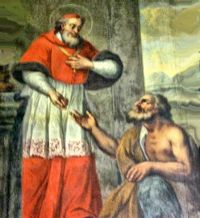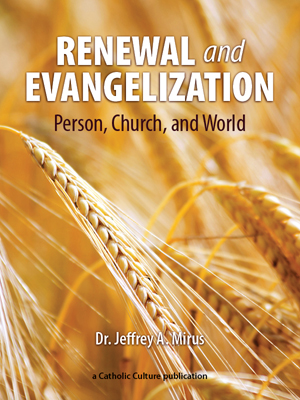Easter: April 9th
Tuesday of the Second Week of Easter
Other Commemorations: St. Gaucherius, Hermit (RM); St. Liborius, Bishop (RM); St. Demetrius of Sermium, Martyr (RM)
» Enjoy our Liturgical Seasons series of e-books!
The Roman Martyrology commemorates today:
- St. Gaucherius (1060-1140): He was also know as Walter, abbot-founder and friend of St. Stephen of Grandmont. He founded St. John's Monastery at Aureilfor and a convent for women.
- St. Liborius (d. 396): He was the bishop of Le Mans, France and a friend of Saint Martin of Tours. During the 45 years of his episcopacy he built many churches.
- St. Demetrius of Sirmium (d. 306): He was both soldier and martyr; he suffered in the early 4th century under Maximian. He became immensely popular in the East, where he was called ‘The Great Martyr,’ and subsequently in the West.
Meditation for Tuesday of the Second Week of Easter
The Glorified Body of the Risen Christ
Jesus Himself proves to His Apostles the reality of His Risen Body. But it is a body henceforward exempt from earthly infirmities; this body is agile; matter forms no barrier to it; Jesus rises from the sepulchre hewn out of the rock and whereof the entrance is closed by a heavy stone; He appears in the midst of His disciples: Januis clausis, the doors of the place where they were gathered together being shut. If He takes food with His disciples, it is not because He hungers, but because He wills, by this merciful condescension, to confirm the reality of His Resurrection.
This Risen Body is henceforth immortal. Christ “died once”: Quo enim mortuus est, mortuus est semel. But, says St. Paul, “Christ rising again from the dead, dieth now no more, death shall nor more have dominion over Him”; the body of the Risen Jesus is no longer subject to death nor to the conditions of time: it is free from all servitude, from all infirmities; it is impassible, spiritual, living in a sovereign independence.
—Dom Columba Marmion, Christ in His Mysteries
St. Gaucherius
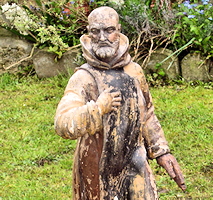 Born in Meulan-sur-Seine to the northwest of Paris, he received a classical education and became a priest. However he felt a deep longing for solitude and a life more radically centered on God. He thereupon devoted his life God as a hermit and began with his friend, Germond, to reside in the area of Limoges. Alone and forgotten by the world, Gaucherius and Germond grew in holiness. Their example attracted others who built hermitages near to theirs. Finally Gaucherius decided to build a monastery at Aureil and to establish two communities, one for men, the other for women, both under the rule of St. Augustine. The passage of an eremitical settlement into the canonical life was one of the principal ways through which the canons regular grew in the 11th and 12th Century. The community of Aureil is typical of these kinds of Ordo Novus canons regular. Thereafter he lived with his companions, being for all a model of sanctity. His companions and disciples include St. Lambert of Angouleme and St. Faucherus as well as the founder of Grandmont monastery, St. Stephen Muret. He died 80 years old in 1140 and was canonized in 1194.
Born in Meulan-sur-Seine to the northwest of Paris, he received a classical education and became a priest. However he felt a deep longing for solitude and a life more radically centered on God. He thereupon devoted his life God as a hermit and began with his friend, Germond, to reside in the area of Limoges. Alone and forgotten by the world, Gaucherius and Germond grew in holiness. Their example attracted others who built hermitages near to theirs. Finally Gaucherius decided to build a monastery at Aureil and to establish two communities, one for men, the other for women, both under the rule of St. Augustine. The passage of an eremitical settlement into the canonical life was one of the principal ways through which the canons regular grew in the 11th and 12th Century. The community of Aureil is typical of these kinds of Ordo Novus canons regular. Thereafter he lived with his companions, being for all a model of sanctity. His companions and disciples include St. Lambert of Angouleme and St. Faucherus as well as the founder of Grandmont monastery, St. Stephen Muret. He died 80 years old in 1140 and was canonized in 1194.
—Excerpted from the Canons Regular of St. Augustine
Patronage: wood cutters
Highlights and Things to Do:
- Read more about St. Gaucherius:
St. Liborius
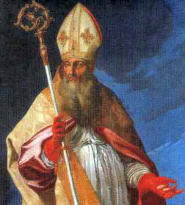 St. Liborius was bishop of Le Mans (348-397), where he labored with signal success. He is said to have healed sufferers from "gravel and allied complaints," and for this reason his feast was introduced by Pope Clement XI, himself a victim who was cured through the saint's intercession. The earliest historical reference dates to the ninth century when his remains were transferred to Paderborn, Westphalia, to aid in the conversion of the Saxons; they are still there at present.
St. Liborius was bishop of Le Mans (348-397), where he labored with signal success. He is said to have healed sufferers from "gravel and allied complaints," and for this reason his feast was introduced by Pope Clement XI, himself a victim who was cured through the saint's intercession. The earliest historical reference dates to the ninth century when his remains were transferred to Paderborn, Westphalia, to aid in the conversion of the Saxons; they are still there at present.
—The Church's Year of Grace, Pius Parsch
Patronage: abdominal pains; against calculi; against colic; against fever; against gall stones; against gravel; against kidney stones; Le Mans, France; Archdiocese and city of Paderborn Germany; Cathedral of Paderborn
Symbols and Representation: Book and several small stones; peacock's feather; bishop carrying small stones on a book; bishop with a peacock; peacock (legend is that when his relics were taken to Paderborn, the procession was led by a peacock); pebbles
Highlights and Things to Do:
- Read more about St. Liborius:
- There is a week-long annual festival, Libori, in Paderborn, Germany, that begins on the Saturday after his July 23rd feast day.
- St. Liborius' relics are located in the Paderborn Cathedral.
St. Demetrius
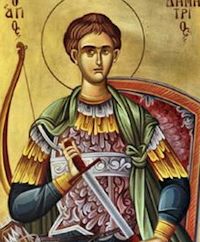 Saint Demetrius was born to a wealthy, noble family and raised Christian. He was a soldier and a Deacon. He was raised to the rank of Duke of Thessaly by the Emperor Maximian. But when he was found to be a Christian he was arrested and imprisoned in a bath-house. He was run through with spears c.306 at Sirmium (in modern Serbia).
Saint Demetrius was born to a wealthy, noble family and raised Christian. He was a soldier and a Deacon. He was raised to the rank of Duke of Thessaly by the Emperor Maximian. But when he was found to be a Christian he was arrested and imprisoned in a bath-house. He was run through with spears c.306 at Sirmium (in modern Serbia).
St. Demetrius was extremely popular in the Middle Ages and was reported to have appeared during a battle in 586, centuries after his death to help defend Thessalonica.
Over 200 churches in the Balkans are known to have been dedicated to him. His relics were said to emit holy oil.
—Excerpted from Evangelizo.org 2001-2014
Demetrius was probably a deacon who was martyred sometime before the fifth century at Sirmium (Mitrovic in former Yugoslavia). During that century two churches were built in his honor, one at Sirmium and the other at Thessalonica. It may be that the cult of the saint migrated from Sirmium when Leontius, the prefect of Illyricum, moved the seat of civil suthority to Thessalonica–he is reputed to have built both churches. Certainly Demetrius was honored as a saint at Sirmium before the church at Thessalonica was built. Sirmium, however, was destroyed by the invading Huns in 441, and it was the second church that became the principal center for the cult of the martyr and attracted very large numbers of pilgrims. The church was destroyed by fire in 1917 but has since been rebuilt; it was obviously meant to hold a great number of people.
In time Demetrius became known as "the Great Martyr," and a legend grew up about his life. According to this he had been a citizen of Thessalonica who had been arrested for preaching the gospel and executed without trial in the local baths.The church was built over the baths and incorporated part of them as a kind of crypt. At a later date relics of the saint were said to exude a miraculous oil, but the arrangements whereby the pilgrims could collect some of this seem to have been quite fraudulent.
The earliest written account we have dates from the ninth century and says that the order for his execution came from the emperor Maximian himself. Later accounts make out that he was a proconsul (this is how the Roman Martyrology described him) or a warrior-saint similar to St. George and second only to him in popularity. He as one of the saints adopted by the Crusaders as their patrons in battle. None of these later accounts can be trusted, though we can be sure of the existence of a martyr of that name. His feastday is kept with great solemnity throughout the Eastern Church on October 26, and he is named in the preparation of the Byzantine liturgy. The popular Slav name, Dmitry, comes from him. His cult was popular also in Ravenna in Italy, where the earliest chapel was dedicated in his honor.
The original basilica, destroyed in 1917, had important mosaics from the sixth to the ninth century; in these Demetrius was portrayed as a deacon. More often he was depicted as a soldier.
—Excerpted from Butler's Lives of the Saints, Volume 10
Patronage: Crusaders; soldiers; Belgrade, Serbia; Salonica, Greece; Thessaloniki, Greece
Highlights and Things to Do:
- Learn more about St. Demetrius:




